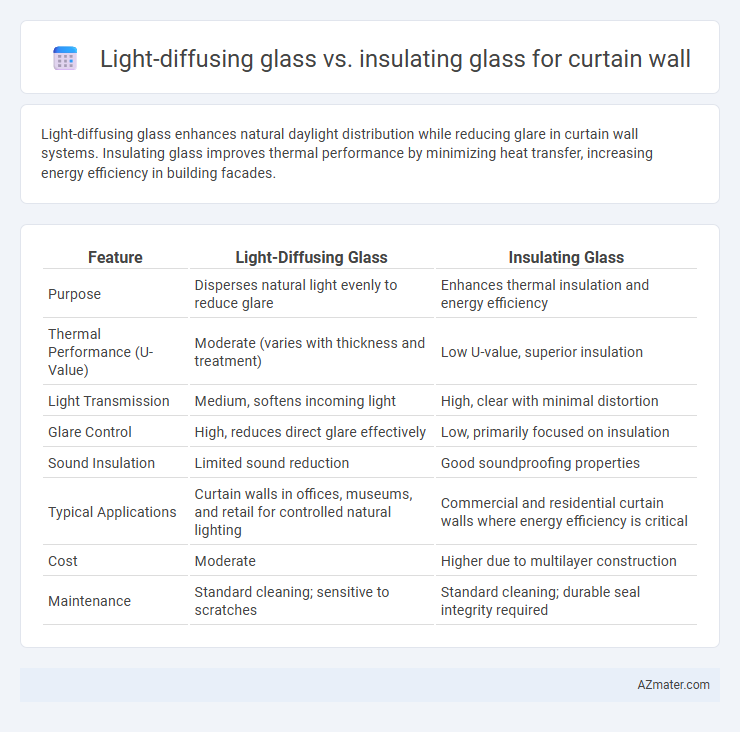Light-diffusing glass enhances natural daylight distribution while reducing glare in curtain wall systems. Insulating glass improves thermal performance by minimizing heat transfer, increasing energy efficiency in building facades.
Table of Comparison
| Feature | Light-Diffusing Glass | Insulating Glass |
|---|---|---|
| Purpose | Disperses natural light evenly to reduce glare | Enhances thermal insulation and energy efficiency |
| Thermal Performance (U-Value) | Moderate (varies with thickness and treatment) | Low U-value, superior insulation |
| Light Transmission | Medium, softens incoming light | High, clear with minimal distortion |
| Glare Control | High, reduces direct glare effectively | Low, primarily focused on insulation |
| Sound Insulation | Limited sound reduction | Good soundproofing properties |
| Typical Applications | Curtain walls in offices, museums, and retail for controlled natural lighting | Commercial and residential curtain walls where energy efficiency is critical |
| Cost | Moderate | Higher due to multilayer construction |
| Maintenance | Standard cleaning; sensitive to scratches | Standard cleaning; durable seal integrity required |
Introduction to Curtain Wall Glass Options
Curtain wall glass options include light-diffusing glass, which evenly distributes natural light to reduce glare and enhance interior comfort, and insulating glass, designed to improve thermal performance by minimizing heat transfer. Light-diffusing glass is ideal for creating well-lit, visually comfortable spaces, while insulating glass helps achieve energy efficiency by maintaining consistent indoor temperatures. Selecting the appropriate glass type depends on balancing daylight management with thermal insulation requirements for the building facade.
What is Light-Diffusing Glass?
Light-diffusing glass for curtain walls is designed to scatter incoming light, creating a uniform and glare-free illumination while maintaining transparency and visual comfort. It enhances natural daylight distribution inside buildings, reducing the need for artificial lighting and improving energy efficiency. Unlike insulating glass, which primarily focuses on thermal performance by providing an air or gas-filled gap to reduce heat transfer, light-diffusing glass focuses on optimizing indoor lighting quality through light scattering technology.
What is Insulating Glass?
Insulating glass, also known as double-glazing, consists of two or more glass panes separated by a sealed air or gas-filled space to reduce heat transfer and improve energy efficiency in curtain walls. This type of glass enhances thermal insulation by minimizing heat loss in cold climates and reducing heat gain in warm conditions, contributing to lower energy costs and increased occupant comfort. Compared to light-diffusing glass, insulating glass primarily focuses on thermal performance rather than light scattering, making it ideal for energy-conscious building designs.
Light-Diffusing Glass: Key Features
Light-diffusing glass for curtain walls enhances natural daylight distribution, reducing glare and improving indoor visual comfort by scattering incoming light evenly. This glass type is engineered with micro-structures or embedded materials that diffuse sunlight, optimizing energy efficiency by lowering cooling loads and minimizing artificial lighting needs. Compared to insulating glass, light-diffusing glass emphasizes light quality and uniformity while maintaining acceptable thermal performance for building envelope applications.
Insulating Glass: Key Features
Insulating glass for curtain walls features superior thermal performance due to its dual or triple-pane construction filled with inert gas, reducing heat transfer and enhancing energy efficiency. It incorporates low-emissivity coatings that reflect infrared energy while allowing visible light, maintaining indoor temperature stability and reducing HVAC costs. The robust design also offers improved sound insulation and condensation resistance, making it ideal for sustainable building envelopes.
Energy Efficiency Comparison
Light-diffusing glass enhances energy efficiency in curtain walls by reducing glare and distributing natural light more evenly, thereby decreasing reliance on artificial lighting and contributing to lower cooling loads. Insulating glass units (IGUs) provide superior thermal performance by minimizing heat transfer through multiple glass layers and gas fills, significantly improving the building's overall thermal insulation (U-value). While light-diffusing glass optimizes daylight utilization, insulating glass excels in reducing energy consumption for heating and cooling, making IGUs generally more effective in comprehensive energy efficiency strategies.
Impact on Interior Comfort and Lighting
Light-diffusing glass in curtain walls enhances interior comfort by distributing natural light evenly, minimizing glare and reducing harsh shadows, which creates a balanced and visually pleasant environment. Insulating glass improves thermal comfort by providing superior thermal resistance, reducing heat transfer and maintaining consistent indoor temperatures, which decreases reliance on HVAC systems. Combining both technologies can optimize lighting quality and energy efficiency, maximizing occupant comfort throughout varying daylight conditions.
Aesthetic Considerations for Curtain Walls
Light-diffusing glass enhances curtain wall aesthetics by creating uniform, soft illumination that reduces glare and highlights architectural features, offering a sleek, modern appearance. Insulating glass improves energy efficiency and thermal comfort, maintaining clear views while supporting sustainable design goals without compromising visual clarity. Selecting between them depends on balancing desired visual effects with performance requirements for a building's facade.
Cost Analysis: Light-Diffusing vs Insulating Glass
Light-diffusing glass for curtain walls typically incurs higher initial costs due to specialized manufacturing processes that embed diffuser materials, enhancing natural light dispersion while maintaining privacy. Insulating glass, featuring double or triple glazing with inert gas fills and low-emissivity coatings, offers long-term energy savings by improving thermal efficiency but often comes with higher upfront investment compared to standard single-pane options. Cost analysis reveals that while light-diffusing glass may elevate project expenses initially, insulating glass delivers greater life-cycle cost benefits through reduced heating and cooling demands, making the optimal choice dependent on a balance between aesthetic goals and sustainability priorities.
Choosing the Right Glass Type for Your Project
Selecting the right glass type for curtain walls depends on balancing light diffusion and thermal insulation needs. Light-diffusing glass enhances natural daylight distribution, reducing glare and creating a softer interior ambiance, ideal for spaces requiring visual comfort. Insulating glass provides superior thermal performance by minimizing heat transfer, boosting energy efficiency and maintaining consistent indoor temperatures, making it essential for climates with extreme weather conditions or energy-conscious designs.

Infographic: Light-diffusing glass vs Insulating glass for Curtain wall
 azmater.com
azmater.com